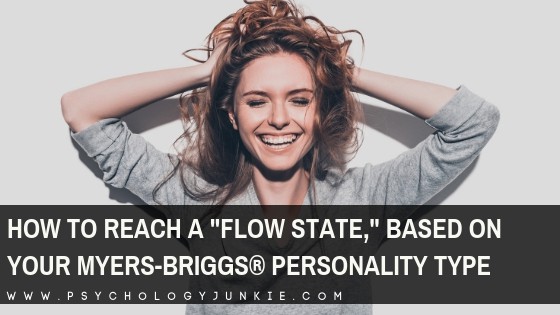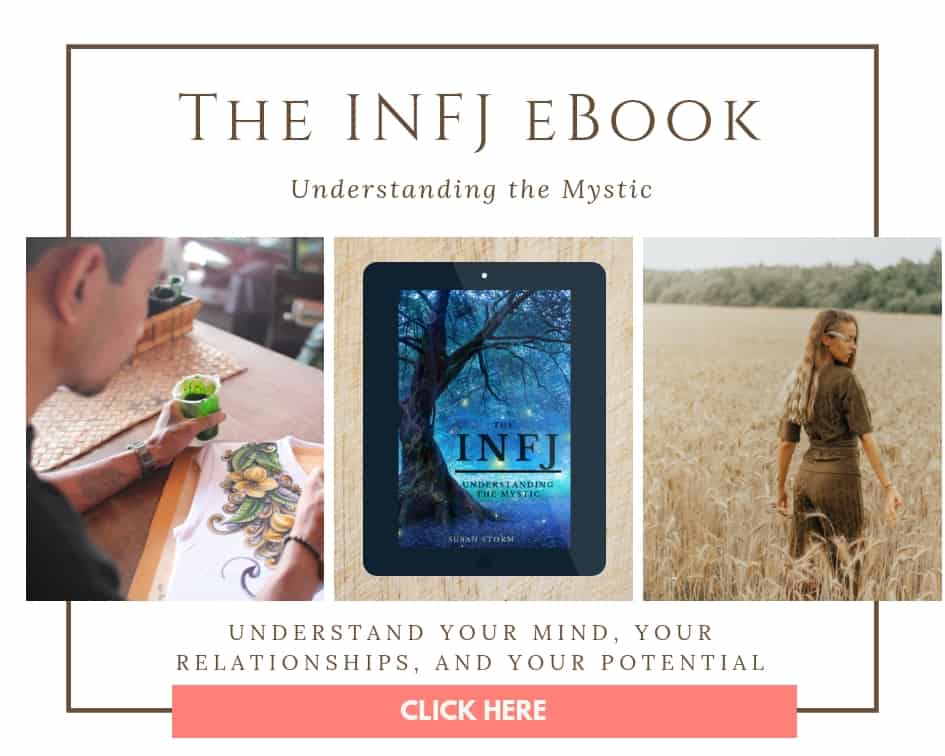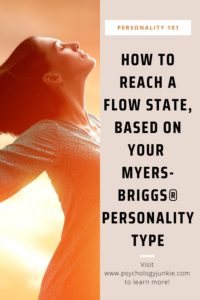How to Reach a “Flow State” Based on Your Personality Type
Have you ever felt like you were mentally “in the zone” and able to complete tasks easily and with a sense of immediate satisfaction and calm? During these phases you feel energized, focused, and fully immersed in what you are doing. You feel like you were “made to do this.” Time falls away. You might be tired, but you won’t notice.
Flow experiences can occur in different ways for different people depending on their personality type. Some enter a flow state while painting or drawing while others enter a flow state when running or playing tennis. Today we’re going to explore how you can achieve a flow state, based on your unique personality type.

Not sure what your personality type is? Take our new personality questionnaire!
How to Reach a “Flow State,” Based on Your Personality Type
ENFPs and ENTPs
If you are an ENxP personality type then what naturally gets you in flow is using your dominant function, Extraverted Intuition (Ne). Your dominant function is the “driver” of your personality. This is the function that gets you excited, comes most naturally to you, and makes you feel alive. Typologist John Beebe calls this function the “Hero,” because it takes on a heroic tone when being used. Whenever you tap into extraverted intuition, you will feel a sense of satisfaction. Continued use can propel you into a flow state and allow you to bring all kinds of ideas and possibilities into the world.
So what is Extraverted Intuition?
Extraverted Intuition is an information-gathering process. It’s how ENxPs absorb information from the world around them. But it’s more than that. Ne finds connections, patterns, and relationships between the things it sees. It produces and generates possibilities and alternatives.
ENxPs can imagine new scenarios and almost immediately create multiple options. Whenever a door closes they open 10, 100, or even 1000 windows. They think, “Look world! See all these possibilities?” It can be difficult for ENxPs to understand how other people can feel stuck or without options when there are so many alternatives to consider. The only barrier to this mindset is when ENxPs are under extreme stress – when this happens they tend to feel like their options are limited and the walls are closing in on them. Brainstorming under extreme stress can make ENxPs feel incompetent, anxious, and exhausted.
How to Reach a “Ne” Flow State:
Flow state can be achieved differently for different ENxPs, but here are some examples of ways to activate it:
- Change the pattern. Mentally look for a pattern that you don’t like. How could you create alternatives to that pattern? How could you disrupt it and make things better?
- Create possibilities. Look around you. What alternatives, ideas, and possibilities exist that nobody is thinking of? Do something unexpected! Take a (safe) risk. Imagine going somewhere you’ve never been before and figure out what’s stopping you from getting there so that you can shatter that roadblock.
- Combine ideas into a creative pursuit. See if you can gather all your interests into one unified possibility or opportunity. Are you an entrepreneur who loves the ocean and meeting new people? Perhaps you could attend a networking event or create a workshop for your clients in a coastal state. Do you love painting, exercising, and music? Perhaps you could take a walk with your camera while listening to music and take photos of landscapes you’d like to paint later!
- Find the positive in a situation. Imagine what good could come out of a negative situation. What’s good about it raining on the day you planned to go to the park? What good could come out of not being promoted? Is there an opportunity there that you haven’t yet considered?
- Find a friend or family member who inspires you. Start generating options and ideas together. Discuss a philosophy, an opportunity, an adventure, a risk. The more novel and exciting ideas you can create the easier it will be for you to enter a flow state.
ENFPs might also be able to reach a flow state using the methods listed for INFPs and ISFPs (scroll down to see them!). ENTPs might also be able to reach a flow state using the methods listed for INTPs and ISTPs.
Read This Next: Here’s What It’s Like Inside the Mind of an ENFP, ENTP, INFP or INTP
INFJs and INTJs
If you are an INxJ then you reach a flow state by tapping into your dominant function, Introverted Intuition (Ni). This function is what drives you and absorbs most of your focus when you’re alone. John Beebe, Distinguished Fellow of the American Psychiatric Association, calls this function “the Hero.” As your hero function, you feel confident and determined when using it. You may feel like you are “leading the charge” and sure of your direction.
So what is Introverted Intuition?
Introverted Intuition (Ni) is an information-gathering process, which means that you use it when you observe the world around you and the world inside yourself. This function is not focused on making a judgment or a moral or ethical assessment. It works on its own timetable in unpredictable ways, noticing subtleties and asking, “What else is going on here?” Ni is focused on foreseeing trends, patterns, and implications. When you’re tapped into this mental process you see meaning and symbolism attached to what’s going on around you. You get flashes of insight into the essential nature of things and their complex interrelationships. You get a sense about where things will lead. This vision is often accompanied with a sense of certainty, as if you know for sure where things will lead or how a strategy or pattern will unfold.
How to Reach a “Ni” Flow State:
Some INxJs will experience flow more easily from certain activities over others. What works for you might be unique, but here are some activities that tend to work well:
- Spend some time each day in a quiet place. Allow ideas to come into your consciousness without pressure. Don’t try to control your mind. As ideas flow through you, write them down (or draw them).
- Imagine yourself without limits or boundaries. What would you do? What would you be?
- Project yourself into the future. Let images and visuals come to you. Sink into what you see and imagine. Close your eyes. Afterwards, write down what came to you. Is there any way that you could make that vision a reality?
- Play a strategy game that requires you to focus on a future outcome and backtrack to create a very specific plan.
INFJs might also be able to reach a flow state using the methods listed for ESFJs and ENFJs (scroll down to see them!). INTJs might also be able to reach a flow state using the methods listed for ESTJs and ENTJS (scroll down to see).
Read These Next: The Unique Intelligence of INFJs, INTJs, ENFJs and ENTJs
7 Things That INFJs Experience as Children
The Childhood Struggles of INTJs
ESFPs and ESTPs
If you are an ESxP, then the process that naturally gets you into a flow state is called Extraverted Sensation, or “Se” for short. When you’re tapped into Se you feel confident, capable, excited. You feel ready for anything and sure of yourself. There’s an adrenaline rush and a sense of near heroic capability. Joel Mark-Witt and Antonia-Dodge from Personality Hacker call this the “Driver” function because it’s the function that drives you and propels you through most of life. It also tends to have the most maturity of all of your cognitive functions.
So What is Extraverted Sensation?
Extraverted sensation (Se) is an information-gathering process. It’s what you use when you absorb information from the outside world and respond to it without having to consciously sit down and “judge” it in-depth. Se is focused on the current, objective, external world and reality. As an ESxP you want to immerse yourself in the details of your environment. You want to absorb energy and enjoyment from nature, action, people, and events. When you’re in tune with the world around you, highly aware of all that’s happening, and ready to respond reflexively, you’re using Se. Whether this means you’re playing a sport, dancing, tasting an exotic new food, playing dodge-ball, rescuing someone from a burning building, or simply swapping jokes with someone new. Se is activated when you “let go” and let yourself be fully present to your surroundings and immersed in every detail.
How to Reach a “Se” Flow State:
What works for some ESxPs might not work for others, but here are several methods that often work:
- Delve into your five senses. Close your eyes and focus fully on the taste you’re experiencing when you try something new. Listen to music and notice every rhythm, change in tempo, and every note being played. Notice the textures of everything you feel in detail. What’s something that excites you that you could physically explore?
- Play a game that requires quick reaction time. Sports, dodge-ball, Taboo, slapjack, video games. Pick something that taps into your quick reflexes and attentiveness to your surroundings.
- Seek additional experiences. Go safely white-water rafting, kayaking, parasailing, horseback riding. Get a massage, join a roller-derby team, or just go to a restaurant you’ve never been to before. Embrace your natural sense of adventure!
- Merge with your environment. Ride your bike and become one with the pedals, the breeze, and the birds flying . Drive your car and feel a sense of power and independence as your press the gas pedal. Become one with the road, your vehicle, and the music playing on the radio.
ESTPs might also be able to reach a flow state by using the methods listed for ISTPs and INTPs (scroll down to see them!). ESFPs might also be able to reach a flow state by using the methods listed for ISFPs and INFPs (scroll down to see!).
Read This Next: The Unique Intelligence of ESFPs, ESTPs, ISFPs, and ISTPs
ISTJs and ISFJs
As an ISxJ your most refined mental process is called Introverted Sensation, or “Si” for short. This is the process that is the easiest for you to use, the one that comes most naturally. When you’re experiencing Si you tend to feel confident of yourself, and sure of the information you’re gathering.
So What is Introverted Sensation?
Introverted sensation is an information-gathering process. This means that what gets you in flow isn’t making decisions or coming to conclusions. It’s simply relaxing into reflections, gathering data, and absorbing impressions. As you absorb information you compare your current experiences to your past impressions and memories. You use past experience as a guide for exploring what’s happening right now – How could your life lessons improve this current experience? How does this compare? What has changed? You see the current world through a set of subjective internal filters. It’s as if the current experience is overlaid with lush images of comparable past experiences. This makes you quick to notice patterns and inconsistencies.
As a Si user you’re also highly in tune with how things feel inside your body. You consistently notice when you are hungry, thirsty, tired, or becoming ill. As a result you prize certain healthy or comforting routines and spend a lot of your life trying to create a sense of stability, tranquility, and routine.
How to Reach a “Si” Flow State:
What works for some ISxJs might not work for others, but here are several methods that often work well:
- Reflect on how you are feeling inside your body. Are you hungry, tired, stressed? Do something to relieve whatever discomfort you are feeling. Really sink into the sensation of drinking water when you’re thirsty, and when you lay down in bed really let every muscle in your body relax and savor each tiny detail and physical sensation.
- Close your eyes and recall one of your favorite past memories. Remember every detail exactly as it was and don’t rush yourself. Experience the joy of re-living something beautiful and the realization that you can enjoy these moments again and again even though they are in the past.
- Meditate and focus on your body sensations. Let your body fully relax.
- Learn a repetitive skill like knitting, golfing, cycling, or crocheting. Learn to do it so well that it becomes simple and soothing. Let yourself develop mastery in this skill while you’re able to let your body relax and enjoy the progress you’re making.
ISTJs might also be able to reach flow using the methods listed for ENTJs & ESTJs. ISFJs might also be able to reach flow using the methods listed for ESFJs & ENFJs.
Read This Next: 10 Unique Qualities of the ISTJ, ISFJ, ESTJ and ESFJ Personality Types
ESFJs and ENFJs
As an ExFJ, the “leading role” in your mind is a mental process called Extraverted Feeling. This function is the one that reaches maturity first in your life and the one you trust most of all. You call this process into use with ease and without expending a lot of energy and willpower. It’s so important to how you mentally operate that it would feel strange not to use it.
So What is Extraverted Feeling?
Extraverted Feeling (Fe) is a decision-making process. That means that it’s what you use when you evaluate, reach for closure, and analyze the information you’ve received in order to make a decision or movement in life. For you, the outer world of people, their needs, emotions, and values is the world that drives you. You are driven to interact with people, to understand what’s important to them, to maintain harmony. You seem to have an innate sense of the emotional “temperature” of the room you’re in and you try to make sure people feel like they are valued and given a priority. You are likely tactful, polite, and sensitive to praise and criticism. You also have ideals and plans about how to improve things in the world. You try hard to achieve those ideals and can be very loyal and persevering in dedication of your cause.
How to Reach a “Fe” Flow State:
What works for some ExFJs might not work for others, but here are several methods that often work well:
- Watch psychological dramas or movie/TV shows that are all about human relationships, emotions, and thought processes. Think about what makes the people “tick” and analyze the relationships in the show. Is there anything you can learn from that? How can that impact your personal relationships?
- Absorb good vibes. Spend time around friends doing something you all love. Let yourself absorb their positive emotions and fully immerse yourself in their joy, laughter, and good feelings.
- Plan an experience that will make the people you love happy. Imagine the details and their specific responses as you prepare this experience.
- Stand up for your values compassionately. Speak up in defense of a value you care about that will positively impact others. Make graphics to showcase your cause. You could also persuade people through conversation, but do so using your gift for harmony and tact. Use warmth and empathy to convey what you believe in.
ESFJs might also be able to reach a flow state using the methods listed for ISFJs and ISTJs. ENFJs might also be able to reach a flow state using the methods listed for INFJs and INTJs.
Read This Next: Are ENFJs and ESFJs “Fake”?
INFPs and ISFPs
If you are an IxFP, then the process that naturally gets you into flow is called Introverted Feeling, or “Fi” for short. You feel a strong sense of “rightness” when you are tapped into this function. This feels like “home” to you – the place you are supposed to be. Introverted feeling subjects are the kinds of things you feel you are meant to think about it. John Beebe calls this the “Hero” function, and you likely feel like you’re taking up the charge and doing what is best when you are tapped into this zone.
But what is Introverted Feeling?
Introverted Feeling (Fi) is a decision-making process. When you focus on what you will do, how you will do it, what the best direction for your life is, you will access Fi. Fi focuses on your inner world and what seems right and authentic to you. It’s the part of you that assesses whether you’re living in congruence with your beliefs, or in alignment with what you love. It’s the voice in your head that says, “Damn social conventions. I need to do what I think is right.” Fi focuses on the individual rather than the collective. You want to find your true purpose, your true beliefs, ethics, morals, desires, and you don’t care if it does or doesn’t line up with what’s “normal” or socially acceptable.
How to Reach a “Fi” Flow State:
Flow state can be achieved differently for different IxFPs, but here are some methods that tend to work:
- Think of Your Convictions. What would you be willing to die for? What convictions demand your energy and focus? Write those down. Find a poem that aligns with them. Watch a movie where someone upholds a similar conviction against all odds. Listen to a song that aligns with your convictions.
- Look at your life and figure out which duties are misaligned with your values. Which can you extricate from your life? Is there a random task or routine that is stopping you from living in inner harmony? Be careful with some of these. You don’t want to make a decision that you’ll later regret.
- Imagine your utopia. What would it be like? What values would be upheld? What ethics would be maintained? How can you make your current world more like that world without impeding on anyone’s freedoms.
- Just say “No” to duties or obligations that don’t feel right to you. Enjoy the freedom you feel afterwards.
- Find a cause that aligns with your deepest values. Find a way to support that cause that aligns with your talents. Could you blog about that cause? Could you help people one-on-one who are affected by that cause? For example, if you care about foster dogs, you could foster them yourself, blog about your experiences, share the posts on social media so that those dogs would get adopted. You could become an advocate for dogs at your local animal shelter.
INFPs might also be able to reach a flow state using the methods listed for ENFPs and ENTPs (scroll up to see them!). ISFPs might also be able to reach a flow state using the methods listed for ESFPs and ESTPs (scroll up to see them!).
Read These Next: How Others See You, Based on Your Personality Type
INFPs, ISFPs and Empathic Mirroring
ESTJs and ENTJs
As an ExTJ your most relied-upon mental process is Extraverted Thinking, or “Te” for short. Experiencing Te and using it gives you a sense of satisfaction and confidence. You feel sure of yourself, more-so than when you use any other process. When you can’t tap into this function you feel stressed and uncertain, as if you can’t think clearly.
So What Is Extraverted Thinking?
Extraverted Thinking is a decision-making process, or as Isabel Briggs-Myers called it, a “Judging” function. This means that it’s the function you use when you’re analyzing information in order to move forward. As a Te-dominant type you like organizing your outer world for maximum efficiency and effectiveness. You are energized by reaching goals and you do so by employing proven analytical tools, spotting inconsistencies and inefficiencies, and clarifying rules, regulations, and standards. You highly value competence in others and yourself. You’re a strong believer in fairness and justice and believe that each person is independently responsible for their own actions and should be held accountable to a universal set of rules.
How to Reach a “Te” Flow State:
What works for some ExTJs might not work for others, but here are several methods that seem to work:
- Break-down your ambitions. Choose a goal that you have and change it to something that you can measure. For example, change “I want to get 10,000 subscribers on my YouTube channel” to “I will upload videos every Monday and Wednesday, in an effort to gain 50 subscribers per week. I will measure which videos fail or succeed and monopolize on those.”
- Listen to an authority on a subject that fascinates you. Notice their logical mindset and take notes on how you can apply their lessons to your life.
- Argue. Get into a debate with someone who won’t take it personally. Use cause and effect and logic to prove your points. Be assertive without becoming angry. At the end of the debate, ask for feedback.
- Think about your day. Which processes can you make more efficient? Think about all the extra time you will create for yourself by getting these tasks maximized.
ESTJs might also be able to reach flow using the methods listed for ISTJs and ISFJs. ENTJs might also be able to reach flow using the methods listed for INFJs and INTJs.
Read This Next: Here’s What ENTJs, ESTJs, ENFJs and ESTPs All Have in Common
ISTPs and INTPs
If you are an IxTP then you reach a state of flow by tapping into your dominant function, Introverted Thinking (Ti). This function is called the “Driver” by some typologists while others call it the “Hero”. When you use this function you feel immersed, focused, and competent. You feel like you are truly in your element and at “home” with what you are doing.
So What is Introverted Thinking?
Introverted Thinking (Ti) is a decision-making process. This means that you use this function when you have to weigh the pros and cons or analyze data to decide which option works best. For you, the subjective, inner world of principles, logic, systems, and categories is what drives you. You seek mental precision and clarity in everything that you do. You want to know how all the pieces of a puzzle fit together – how every piece of a theory or machine works. You seek discovery and a true understanding of everything in the world. You long for accuracy and for things to “make sense.” You want to know how to do things and how systems are composed and fit together. You like figuring things out in your own way without being micro-managed. You get a sense of tremendous contentment when you can make order in your mind from chaotic data.
How to Reach a “Ti” Flow State:
What works for some IxTPs might not work for others, but here are several methods that seem to work:
- Exercise your brain in a game. Play a strategy game, checkers, chess, etc, and look for the underlying structure of the game and how it works. Solve a puzzle or brain-teaser.
- Exercise your need for precision. Write your thoughts down on a paper and search for the most precise, accurate words possible. Keep getting rid of extraneous words until the message is as clear, concise, and precise as possible.
- Go to an escape room and try to make your way out.
- Take something apart and figure out how all the pieces connect. Can you put it back together? Is there a better way for it to be fixed that would make it better than it was before?
- Get into a debate with someone who won’t take it personally. Point out their logical consistencies, and look for the categories they use to defend their decisions. What categories of data are they excluding or relying on? What categories are you ignoring or relying on?
INTPs might also be able to reach a flow state using the methods listed for ENFPs and ENTPs. ISTPs might also be able to reach a flow state using the methods listed for ESTPs and ESFPs.
Read This Next: Here’s What Exhausts You, Based on Your Myers-Briggs® Personality Type
What Are Your Thoughts?
Find out more about your personality type in our eBooks, Discovering You: Unlocking the Power of Personality Type, The INFJ – Understanding the Mystic, and The INFP – Understanding the Dreamer. You can also connect with me via Facebook, Instagram, or Twitter!

















You describe (Ni) as mystical, like all INFJ. If the dynamic of the functions is different. The flow is different as well.
If I don’t focus on one goal, things will not happen like magic. It is a real work of concentration because everything is related to coherence in time and space. It’s all based on factual data that I have no control over.
If I have already thought too much about the problem of something … There, in places or unexpected moments, I will have flash ideas. But a quality work will not come without effort.
The Myers is not a valid psychological test and has no validity or reliability, these are the two characteristic needed for a psychological test to be accepted in court cases. I am a lic clinical psychologist in California and if I used a Myers Briggs results in a court case I would be sued by my client/patient for malpractice and the court would not accept the findings based on the Myers Briggs test results. The Myers Briggs is just a marketing company selling a product that is basically useless at what it is supposed to be doing, measuring your personality type.
That is interesting Anonymous, if a bit dramatic. (I would advise against attempting to introduce MBIT as legal evidence based on your assessment of the likelihood of being sued in civil, if not criminal!, court alone. Good call.)
Where exactly did you earn your credentials btw? And, seriously, why would you go out of your way to visit a personality type site and post your protest in the comments? Honestly, I am curious. And what models do you consider valid?
Thanks in advance for your reply and being a good sport about my teasing. 🙂
Idk who moderates comments, but I know you gotta be tempted to let mine slide lol.
Also, because apparently I am a fan of that word, also in response to my own query. I would like to state my position on the Big Five theory.
As long as it is updated it is okay, but I have strong reservations about the way it was framed originally, with binary metrics that early on were explicitly moral judgements that put half as good and half as bad, and where half tended to be feminine and the, you guessed it, good personality traits were often masculine. I haven’t gone so far as to weight the sides for their material rewards but I think it is a safe bet that it corresponds to the dominant capitalist narrative that invented and continues to perpetuate the idea of the “starving artist,”
See my ebook “The Introvert’s Survival Guide to an Extraverted World: how to thrive as a cat among packs of unleashed canines”
Then I would be curious to know these tests “validated” by the californian justice … The Royal Air Force uses the MBTI: https://eu.themyersbriggs.com/en/About/Case-studies/RAF-Cranwell
Because there are many psychometric data that put the MBTI at the same level as the BIG Five …
That said I don’t see the relationship between MBTI and criminal case … In Europe, usually psychologists/ psychiatrist experts seek to identify disorders, abnormal behavior. The rest is without interest.
Please explain why this was necessary to say? Why did you feel the need to go to a place dedicated to Myers-Briggs system and state it can’t be used in legal stuff?
INTP here, reaching flow for me involves two things. First, having enough understanding of the context in which I’m working to “get” how things go together. If I don’t, research is required.
Second thing. Flow is extremely easy for me if I’m interested in what I’m doing. For me, the key to getting interested in something I might not normally be interested in is to tie that thing to the things I am interested in. For instance, if I need to research something that might be kind of boring, if I can see how the results of that research works help me do more of the things I’m interested in, I can often see it as a part of the process. In essence, I’m doing a part of the thing I’m interested in.
Sometimes don’t this requires some thought and contemplation, luckily, as an introvert I find this relatively simple to do.
I’m an intp as well. I can also enter into a state of flow effortlessly…as long as I’m left alone. Other people offering there narrow minded “advice” and the mundane nagging of “paying the bills” kills all focus and confidence. If you’re of this personality type my suggestion is to puposely ignore everyone and everything until you have established enough passive income to take care of your day to day needs with little effort and have built a space with a door that locks to do what you want without someone trying to “help”.